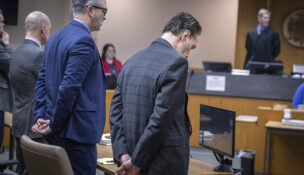Firm brings modeling into eminent-domain litigation
By: Erika Strebel, [email protected]//August 25, 2016//
Firm brings modeling into eminent-domain litigation
By: Erika Strebel, [email protected]//August 25, 2016//

A Cross Plains firm is taking a technology usually seen only in high-stakes litigation with large construction companies and applying it to much smaller eminent-domain cases.
Jim Barmore, owner of Cross Plains-based Harrier GeoGraphics & Construction, has found a niche in creating three-dimensional computer models for use in eminent-domain lawsuits.
Barmore’s business essentially got its start when he produced a drawing for Erik Olsen, an eminent-domain lawyer out of Madison who was working on a case involving a construction project that would have raised a road 50 to 60 feet above a client’s house.
For Olsen, the drawing couldn’t have come at a more opportune time. It proved to be the answer to his long search for a better way to put his clients’ stories across to judges and juries.
“Now more than ever, people communicate visually,” he said. “I had been wishing for someone who could make things more visual.”
Barmore is providing a service that few others can, says Daniel Tal, a 3-D modeling expert out of Colorado who has written books on the topic. Tal, whose blog posts and tutorials taught Barmore much of what he knows about modeling software, recently decided to join Barmore as a partner. The two now plan to combine their knowledge and experience to go beyond working for a single law firm and expand Barmore’s business nationally.
“Given the amount of construction in the Midwest, Colorado and the West … there’s definitely a lot of eminent domain work going on,” Tal said.
Barmore draws on his training in environmental engineering, his experience in construction and his self-taught expertise in 3-D computer modeling to create models often used to support plaintiffs’ contentions in eminent-domain cases. The technology enables Barmore to show what plaintiffs’ properties would look like should their case be lost — an outcome that often means a project will be built on their land.
TAKING FLIGHT
If you’re a lawyer looking to purchase a drone to collect information or to hire a drone operator for a case, take a moment to think about it, suggests Russ Klingaman, a Milwaukee aviation attorney.
For one, lawyers need to be careful that they don’t do anything that would make them a witness in their own cases.
“If you want to get a photograph into evidence and there’s a question about it who took it and what equipment was used to authenticate it … that’s something a lawyer doesn’t want to get involved in,” said Klingaman.
Beyond keeping up with changes relevant to their legal specialty, lawyers must also stay abreast of the latest drone laws, which are in constant flux. New rules went into effect as recently as August. Among other things, they loosened a requirement that had forbid people to operate drones for commercial purposes unless they had first obtained a pilot’s license.
That change alone is worth the attention of lawyers. Among other things, it means that operators that are under less of an obligation to furnish proof of their competence before they can start selling their services.
Because of the change, Klingaman said, lawyers would be wise to thoroughly vet any drone operator they were thinking of hiring. Failing to take that step could lead to embarrassment at trial.
“You want to make sure that they’re following the rules,” Klingaman said. “If I try to present evidence and it turns out they didn’t use the right equipment or didn’t have certification, it could be embarrassing.”
He said it’s important to keep in mind that some of the people who are now trying to make money flying drones may have very little if any formal training. It’s entirely possible, he said, that they’ve learned everything they know on their own.
“There’s … a lot more people who are able to charge, but are they going to be the folks that you want to hire as your witness?”
– Erika Strebel
“With the 3-D model, I can bring a jury, lawyer or judge up to speed in minutes whereas if they were looking at 3-D drawing from engineering view, they’d never understand,” said Barmore.
Barmore’s computer models draw on engineering drawings, surveys, drone flights and similar types of information. Barmore either collects it all himself or relies on public data and information that can be culled from engineering drawings.
His first step is to build a terrain model showing what a plaintiff’s property looks like now. Then, using engineering drawings, Barmore creates a model of whatever project is to be built on that site.
Far more than a picture, the end results allow lawyers to take juries on virtual-reality tours that avoid any reliance on dry and confusing engineering drawings or images that tend to show a project only from one perspective. Also helpful is the models’ ability to map out easements and property lines.
“People are so used to video games and virtual reality that it’s a very good way to communicate,” Olsen said. “In these cases what we’ve found is the more we’re able to communicate the real story, the more success we have. A lot of times whoever the fact finder is, if they really understand what’s going on — we win.”
The icing on the cake, says Olsen, is Barmore’s ability to testify in court in a way that jurors can easily understand. This is where engineers often show themselves to be poor witnesses.
“What Jim did was really figure out how to do it in accurate way and at a reasonable budget that made (the technology) available to for these cases,” Olsen said. “It’s an effective way of presenting information and he does it an economically reasonable way.”
Instead of hiring a team made up of architects, landscape architects, civil engineers and data-visualization designers, Olsen now works exclusively with Barmore. The resulting cost and time savings are tremendous, Olsen said.
Ordinarily, it’s those large teams composed of professionals that produce the models commonly used in lawsuits involving construction defects and other high-stakes matters. Tal said going that route can easily cost a firm $60,000.
Barmore’s services go for a fraction of that, Tal said.
Besides his ability to wear different hats, Barmore attributes his lower costs to the fact that it has only become easier in recent years to obtain devices of the sort he routinely relies on. Drones, in particular, are now affordable enough that an ordinary person can buy one and get a permit to fly it.
Drones remove many of the barriers that had previously made it difficult to gather certain types of data about a property. Before drones, designers found themselves often relying on expensive helicopter or airplane flights.
So, says Tal, don’t be surprised if the technology creeps into other areas of law.
“3-D modeling is going to proliferate,” he said. “You’re going to see it everywhere.”
Legal News
- FBI launches criminal investigation into Key Bridge collapse
- Man charged in slaying after woman’s leg found at Milwaukee-area park
- Minnesota man guilty in fatal stabbing of teen on Wisconsin river, jury finds
- Wisconsin teen sentenced in bonfire explosion that burned at least 17
- Wisconsin man who broke into home, ate victim’s chicken, slept in victim’s bed, receives prison and jail sentences
- Judge refuses to dismiss Hunter Biden’s gun case
- House passes reauthorization of key US surveillance program after days of upheaval over changes
- Milwaukee Police officer traveling to Georgia training retires before facing discipline
- Evers to ask legislature to approve largest increase in state support for UW System in two decades
- 7th Circuit Court of Appeals proposes new rules
- Federal agencies allege toxic work environment for women in new report
- Wisconsin man sentenced for sex trafficking a woman and a minor online
WLJ People
- Power 30 Personal Injury Attorneys – Russell Nicolet
- Power 30 Personal Injury Attorneys – Benjamin Nicolet
- Power 30 Personal Injury Attorneys – Dustin T. Woehl
- Power 30 Personal Injury Attorneys – Katherine Metzger
- Power 30 Personal Injury Attorneys – Joseph Ryan
- Power 30 Personal Injury Attorneys – James M. Ryan
- Power 30 Personal Injury Attorneys – Dana Wachs
- Power 30 Personal Injury Attorneys – Mark L. Thomsen
- Power 30 Personal Injury Attorneys – Matthew Lein
- Power 30 Personal Injury Attorneys – Jeffrey A. Pitman
- Power 30 Personal Injury Attorneys – William Pemberton
- Power 30 Personal Injury Attorneys – Howard S. Sicula











